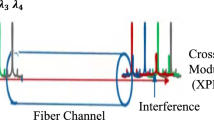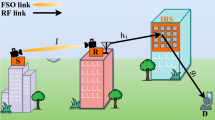Abstract
An analytical modeling and performance analysis for a multiple-input multiple-output orthogonal frequency division multiplexing (MIMO-OFDM) transceiver exhibiting crosstalk and nonlinear distortion in transmitting chain is presented. For this purpose, a two-dimensional memory polynomial is used to describe the dynamic nonlinear MIMO transmitter. It is shown that the impairment of nonlinear crosstalk can be characterized by two complex attenuations and a nonlinear additive noise. Moreover, an analytical formulation for the symbol error rate (SER) of MIMO-OFDM system considering a frequency selective channel is provided. Experimental results have been employed to extract a realistic model for the nonlinear transmitter in the presence of crosstalk. Also, a model of the linearized transmitter has been calculated after experimentally applying digital predistortion (DPD). The proposed model for the system is validated by the simulation results and a good agreement between the analytical and simulation results is observed. Finally, it is shown that nonlinear crosstalk degrades SER of the system, whereas, the DPD can effectively compensate for the nonlinearity and crosstalk infections, which, in turn, improves SER of the MIMO-OFDM system.







Similar content being viewed by others
References
Zhu, H., & Wang, J. (2012). Chunk-based resource allocation in OFDMA systems—Part II: Joint chunk, power and bit allocation. IEEE Transactions on Communications, 60(6), 499–509.
Zhu, H., & Wang, J. (2009). Chunk-based resource allocation in OFDMA systems—Part I: Chunk allocation. IEEE Transactions on Communications, 57(9), 2734–2744.
Zhu, H. (2012). Radio resource allocation for OFDMA systems in high speed environments. IEEE Journal on Selected Areas in Communications, 30(4), 748–759.
Paulraj, A. J., Gore, D. A., Nabar, R. U., & Bolcskei, H. (2004). An overview of MIMO communications—A key to gigabit wireless. Proceedings of the IEEE, 92(2), 198–218.
Gesbert, D., Shafi, M., Shiu, D., Smith, P. J., & Naguib, A. (2003). From theory to practice: An overview of MIMO space-time coded wireless systems. IEEE Journal on Selected Areas in Communications, 21(3), 281–302.
Gregorio, F., Werner, S., Cousseau, J., & Laakso, T. I. (2007). Receiver cancellation technique for nonlinear power amplifier distortion in SDMA OFDM systems. IEEE Transactions on Vehicular Technology, 56(5), 2499–2516.
Vaezi, A., Abdipour, A., & Mohammadi, A. (2012). Nonlinear analysis of microwave amplifiers excited by multicarrier modulated signals using envelop transient technique. Analog Integrated Circuits and signal Processing, 73(1), 1–11.
Vaezi, A., Abdipour, A., & Mohammadi, A. (2011). Analysis of nonlinear microwave circuits excited by multi-tone signals using artificial frequency mapping method. Informacije MIDEM, Journal of Microelectronics, Electronic Components and Materials, 41(3), 182–185.
Bohara, V. A., & Ting, S. H. (2009). Analytical performance of orthogonal frequency division multiplexing systems impaired by a non-linear high power amplifier with memory. IET Communications, 3(10), 1659–1666.
Vaezi, A., Abdipour, A., Mohammadi, A., & Ghannouchi, F. M. (2016). Analysis of MIMO-OFDM system impaired by nonlinear dual-band power amplifiers. Analog Integrated Circuits and Signal Processing, 89(1), 205–212.
Madani, M. H., Abdipour, A., & Mohammadi, A. (2010). Analytical performance evaluation of the OFDM systems in the presence of jointly fifth order nonlinearity and phase noise. Journal of Analog Integrated Circuits and Signal Processing, 66(1), 103–115.
Sulyman, A. I., & Ibnkahla, M. (2008). Performance of MIMO systems with antenna selection over nonlinear fading channels. IEEE Journal of Selected Topics in Signal Processing, 2(4), 1–12.
Qi, J., & Aissa, S. (2010). Analysis and compensation of power amplifier nonlinearity in MIMO transmit diversity systems. IEEE Transactions on Vehicular Technology, 59(6), 2921–2931.
Hemesi, H., Abdipour, A., & Mohammadi, A. (2013). Analytical modeling of MIMO-OFDM system in the presence of nonlinear power amplifier with memory. IEEE Transactions on Communications, 61, 155–163.
Fu, Z., Anttila, L., Abdelaziz, M., Valkama, M., & Wyglinski, A. M. (2015). Frequency-selective digital predistortion for unwanted emission reduction. IEEE Transactions on Communications, 63(1), 254–267.
Yiming, L., O’Droma, M., & Ye, J. (2014). A practical analysis of performance optimization in OSTBC based nonlinear MIMO-OFDM systems. IEEE Transactions on Communications, 62(3), 930–938.
Iofedov, I., & Wulich, D. (2015). MIMO–OFDM with nonlinear power amplifiers. IEEE Transactions on Communications, 63(12), 4894–4904.
Hemesi, H., Abdipour, A., & Mohammadi, A. (2014). Statistical modelling of a non-linear high-power amplifier with memory in multi-input-multi-output orthogonal frequency division multiplexing systems. IET Communications, 8(5), 714–721.
Palaskas, Y., Ravi, A., Pellerano, S., Carlton, B. R., Elmala, M. A., Bishop, R., et al. (2006). A 5-GHz 108-Mb/s 2 × 2 MIMO transceiver RFIC with fully integrated 20.5-dBm P1dB power amplifiers in 90-nm CMOS. IEEE Journal of Solid-State Circuits, 41(12), 2746–2756.
Bassam, S., Helaoui, M., & Ghannouchi, F. (2009). Crossover digital predistorter for the compensation of crosstalk and nonlinearity in MIMO transmitters. IEEE Transactions on Microwave Theory and Techniques, 57(5), 1119–1128.
Bassam, S. A., Helaoui, M., Boumaiza, S., & Ghannouchi, F. M. (2008). Experimental study of the effects of RF front-end imperfection on theMIMO transmitter performance. In IEEE MTT-S international microwave symposium digest, Atlanta, GA, pp. 1187–1190.
Duman, T. M., & Ghrayeb, A. (2008). Coding for MIMO communication systems. New York: Wiley.
Medvedev, I., Bjerke, B. A., Walton, R., Ketchum, J., Wallace, M., & Howard, S. (2006). A comparison of MIMO receiver structures for 802.11n WLAN—Performance and complexity. In 17th annual IEEE international symposium on personal, indoor and mobile radio communications symposium, pp. 1–5.
Saffar, D., Boulejfen, N., Ghannouchi, F. M., Gharsallah, A., & Helaoui, M. (2011). Behavioral modeling of MIMO nonlinear systems with multivariable polynomials. IEEE Transaction on Microwave Theory and Techniques, 59(11), 2994–3003.
Vejdani Amiri, M., Bassam, S. A., Helaoui, M., & Ghannouchi, F. M. (2013). New order selection technique using information criteria applied to SISO and MIMO systems predistortion. International Journal of Microwave and Wireless Technologies, 5(2), 123–131.
Amin, S., Landin, P. N., Handel, P., & Ronnow, D. (2014). Behavioral modeling and linearization of crosstalk and memory effects in RF MIMO transmitters. IEEE Transactions on Microwave Theory and Techniques, 62(4), 810–823.
Vaezi, A., Abdipour, A., Mohammadi, A., & Ghannouchi, F. M. (2017). On the modeling and compensation of backward crosstalk in MIMO transmitters. IEEE Microwave and Wireless Components Letters, 27(9), 842–844.
Dardari, D., Tralli, V., & Vaccari, A. (2000). A theoretical characterization of nonlinear distortion effects in OFDM systems. IEEE Transactions on Communications, 48(10), 1755–1764.
Helaoui, M., Boumaiza, S., Ghazel, A., & Ghannouchi, F. M. (2006). Power and efficiency enhancement of 3G multi-carrier amplifiers using digital signal processing with experimental validation. IEEE Transactions on Microwave Theory and Techniques, 54(4), 1396–1404.
Zhang, X., Su, Y., & Tao, G. (2010). Signal detection technology research of MIMO-OFDM system. International Congress Image and Signal Processing, 7(11), 3031–3034.
Kiessling, M., & Speidel, J. (2003). Analytical performance of MIMO zero-forcing receivers in correlated ray leigh fading environments. In Proceedings of IEEE workshop SPAWC 2003, pp. 383–387.
Proakis, J., & Salehi, M. (2007). Digital communications, 5th edn. McGraw-Hill.
Hammi, O., Kwan, A., & Ghannouchi, F. M. (2013). Bandwidth and power scalable digital predistorter for compensating dynamic distortions in RF power amplifiers. IEEE Transactions on Broadcasting, 59(3), 520–527.
Author information
Authors and Affiliations
Corresponding author
Appendix
Appendix
1.1 Derivation of complex attenuation coefficients \(\mu_{q,k}^{i,i}\) and \(\mu_{q,k}^{i,j}\)
1.1.1 Derivation of \(\mu_{q,k}^{i,i}\)
As mentioned in Sect. 2, \(\mu_{q,k}^{i,i}\) is weakly dependent on data and its variance is negligible. So, we can assume it as an unknown variable rather than a random one. It can be shown with simulation. So by multiplying (17) by \(a_{k}^{i*}\) and calculating its expected value of expression we have;
Substituting \(\beta_{q,k}^{i}\) from (16) and \(a_{k}^{i*}\) with its IDFT representation form, (36) can be rewritten as:
It is known that IDFT components of i.i.d random sequence is uncorrelated. As mentioned in Sect. 2, \(x_{\left[ n \right]}^{i}\) is modeled as a Gaussian random variable for the large number of N. Therefore, any function of \(x_{{\left[ {n_{i} } \right]}}^{i}\) and \(x_{{\left[ {n_{j} } \right]}}^{i}\) (\(n_{i} \ne n_{j}\)) are independent and \(\left| {x_{{\left[ {n_{i} } \right]}}^{i} } \right|\) is a Rayleigh distributed random variable. So, expected value of any terms in (37) with \(n \ne \upsilon\) is zero, and just the terms corresponding to \(\upsilon = n\) are remained. Also,
\(x_{\left[ n \right]}^{i}\) and \(x_{\left[ n \right]}^{j}\) considered as two circularly symmetric independent complex-valued Gaussian random variables. Also, we know that, \(\left| {x_{\left[ n \right]}^{i} } \right|^{p}\) and \(\left| {x_{\left[ n \right]}^{j} } \right|^{p}\) are random positive numbers. Therefore (38) is reduced to (39).
By using the central moment of Rayleigh random variable and performing some mathematical manipulations, we have:
Thus, (18) can be obtained.
1.1.2 Derivation of \(\mu_{q,k}^{i,j}\)
The method of calculation of \(\mu_{q,k}^{i,j}\) is similar to \(\mu_{q,k}^{i,i}\). Here, the expectation of \(\beta_{q,k}^{i} a_{k}^{j *}\) is calculated and regarding to the (17) we have:
By expanding (41), using (16) and IDFT form of \(a_{k}^{j *}\):
With the same reasoning mentioned for \(\mu_{q,k}^{i,i}\) in (38), the expected value of any terms in (42) with \(n \ne \upsilon\) is zero. So, just the terms corresponding to \(\upsilon = n\) are remained. After some mathematic manipulation and removing zero terms in expectation, we have,
So,
Therefore, \(\mu_{q,k}^{i,j}\) can be expressed as (19).
1.2 Derivation of mean of nonlinear noise \(\eta _{k}^{i}\)
In this section, it is proven that the mean of the nonlinear noise component is zero. For this purpose, by using (17), the expected value of \(\eta _{k}^{i}\) is calculated as;
where;
And the input symbols are zero mean random variables. By substituting (16) in (46), and defining \(\varphi_{p,k}^{i} = \mathop \sum \limits_{q = 0}^{Q - 1} b_{pq }^{i} e_{{}}^{ - j2\pi kq/N}\), we have,
where the expectation is equal to zero if \(\ne \upsilon\), it is considered that \(\upsilon = n\),
Since \(x_{\left[ n \right]}^{i}\) and \(x_{\left[ n \right]}^{j}\) are considered as two circularly symmetric independent zero mean variables, (48) equals to zero. Hence, the mean of the nonlinear noise, \(\eta _{k}^{i}\), is equal to zero.
1.3 Derivation of the variance of nonlinear noise
In this case, as previously mentioned, \(\eta _{k}^{i}\) is assumed independent from input data. So, regarding to (17), we have;
Starting from (47),
where,
Also, since the expected value is equal to zero where \(n_{1} \ne n_{2}\), it is considered that \(n_{1} = n_{2} = n\). By doing some straight mathematical manipulations and removing the zero term, we have:
Using the central moment of Rayleigh distributed random variable results in:
Therefore for the large value of N, we have
By substituting (54) into (49) the variance of nonlinear noise, \(\sigma_{Nl\,k}^{2} \,^{i}\), is calculated.
Rights and permissions
About this article
Cite this article
Vaezi, A., Abdipour, A., Mohammadi, A. et al. Analysis of nonlinear crosstalk impairment in MIMO-OFDM systems. Analog Integr Circ Sig Process 99, 559–569 (2019). https://doi.org/10.1007/s10470-018-1326-y
Received:
Revised:
Accepted:
Published:
Issue Date:
DOI: https://doi.org/10.1007/s10470-018-1326-y




